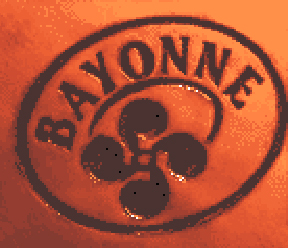Bayonne ham facts for kids

Bayonne ham (or jambon de Bayonne in French) is a type of cured ham. It gets its name from the old port city of Bayonne in southwest France. This city is part of both the Basque Country and Gascony regions. Bayonne ham has a special status called PGI, which means it's a protected product from that specific area.
Contents
How Bayonne Ham is Made
Bayonne ham comes from a special area around the Adour river in France. The rules for making this ham are very strict.
The Pigs and Their Food
The pigs used for Bayonne ham must be from one of eight specific breeds. They are raised in a certain part of France, stretching from Deux-Sèvres in the north to Aveyron and Aude. These pigs are fed naturally, meaning they don't get steroids, fish oils, or antibiotics. Each pig also has a special tattoo or ID to track where it came from. There are also rules about how the pigs are moved, prepared, and stored after they are ready.
Special Status
Because of these strict rules, Bayonne ham has a special European Union PGI status. PGI stands for Protected Geographical Indication. This means only ham made following these rules in the specific area can be called "Bayonne ham." A group called Le Consortium de Jambon du Bayonne makes sure all these rules are followed.
Drying the Ham
The way Bayonne ham is dried today is very similar to how it was done long ago.
- Salting: In the past, pigs were prepared in late autumn. The hams were rubbed with salt from nearby salt pans. The cool temperatures (about 6 to 8 degrees Celsius) during this time were perfect for the first step of preserving the meat. The hams would hang until late winter.
- Sealing: Next, a mix of pork fat and flour, called pannage, is used to seal the cut end of the ham. This helps the ham dry slowly during the warmer spring months.
- Flavor: Some producers also rub a paste of piment d'Espelette (a type of chili pepper from the Basque region) onto the ham's skin. This gives the ham a unique, slightly tangy taste.
- Final Drying: The ham finishes drying by the end of July. Modern drying rooms use special controls to copy the natural temperature and humidity changes of the seasons. A typical ham weighs about 8 to 9 kilograms (about 17 to 20 pounds) with the bone.
The Final Product
Once the ham is fully cured, it gets a special mark: a lauburu (a traditional Basque cross) with the name "Bayonne" above it. The ham must be at least 7 months old before it's sold, but most are 9 or 10 months old. It can be kept for up to another year in a cool, dry place (around 8 degrees Celsius).
Bayonne ham has a slightly sweet and delicate flavor, with not much saltiness. It's usually sliced very thin and has a slightly chewy texture.
See also
 In Spanish: Jamón de Bayona para niños
In Spanish: Jamón de Bayona para niños



